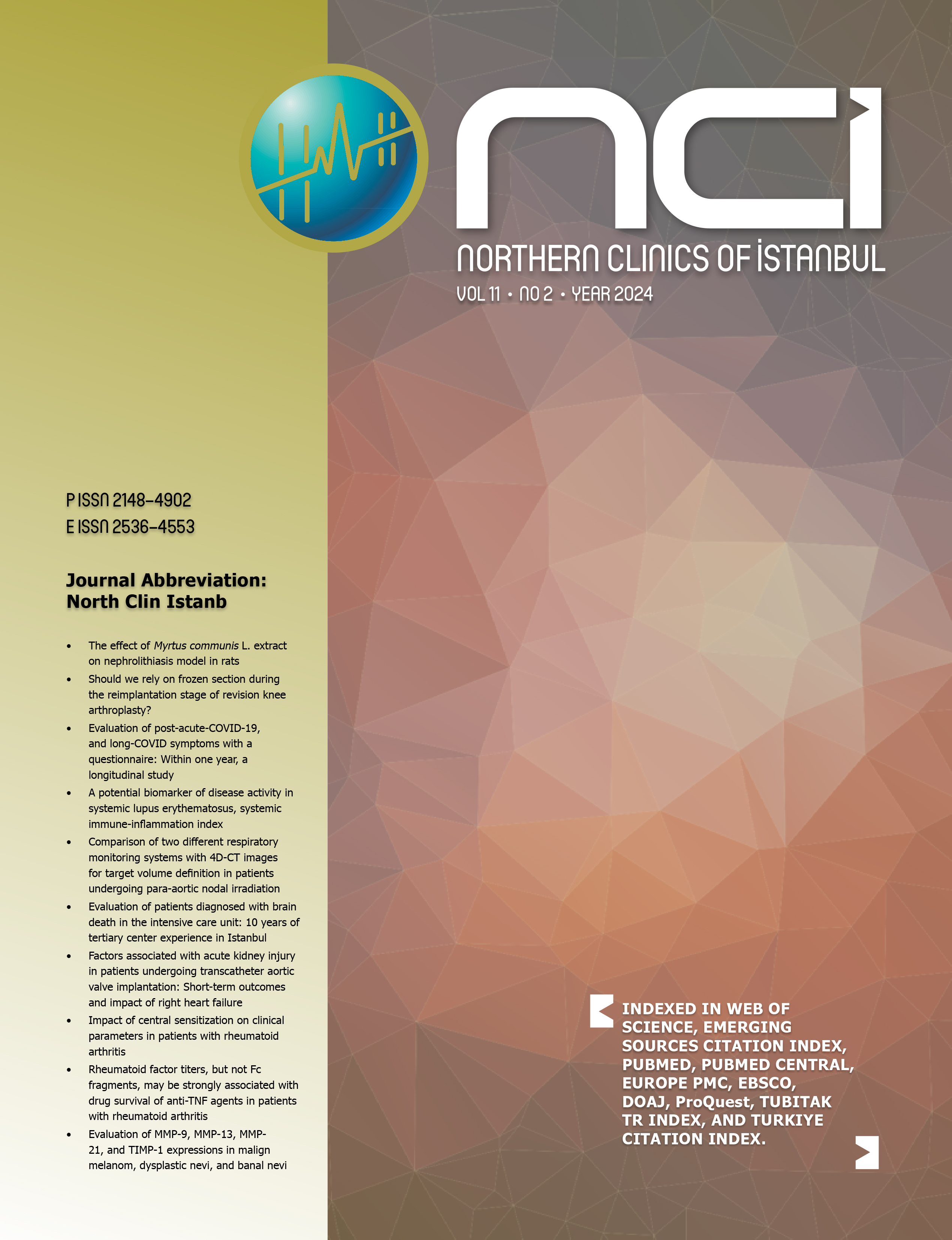Escitalopram co-prescription in anastrozole-treated breast cancer patients
Hazan Ozyurt1, Sevgi Ozden1, Cengiz Gemici1, Elif Esra Kucukibrahimoglu2, Hatice Odabas3, Neset Nesetoglu4, Durisehvar Unal4, Pinar Uler1, Gokhan Yaprak1, Huseyin Tepetam1, Mahmut Gumus5, Mehmet Zafer Gören21Department of Radiation Oncology, Dr. Lutfi Kirdar Kartal Training and Research Hospital, Istanbul, Turkiye2Department of Medical Pharmacology, Marmara University Faculty of Medicine, Istanbul, Turkiye
3Department of Medical Oncology, Dr. Lutfi Kirdar Kartal Training and Research Hospital, Istanbul, Turkiye
4Department of Analytical Chemistry, Istanbul University Faculty of Pharmacy, Istanbul, Turkiye; Drug Application and Research Center, Istanbul University, Istanbul, Turkiye
5Department of Medical Oncology, Medeniyet University Faculty of Medicine, Istanbul, Turkiye
OBJECTIVE: The purpose of the study was to evaluate the impact of escitalopram co-prescription on plasma anastrozole levels in post-menopausal breast cancer patients.
METHODS: A total of 24 post-menopausal operated breast cancer patients co-prescribed with escitalopram and anastrozole were included. Blood samples were collected, before and 1-month after the onset of escitalopram to analyze plasma anastrozole and estradiol levels.
RESULTS: No significant difference was noted in basal plasma anastrozole levels with respect to age, body mass index (BMI), tumor stage, previous antineoplastic treatments, concomitant medications, and serum estradiol levels. Overall, 17 patients completed the 1-month escitalopram treatment, while 7 patients discontinued escitalopram within the 1st week of the treatment. Basal anastrozole levels of 24 patients were 26.1±2.4 ng/mL. Among 17 patients who continued 1-month escitalopram treatment was associated with significant increase in plasma anastrozole levels (24.5±2.3 ng/mL to 32.2±3.2 ng/mL, p<0.05). Notably, 1-month escitalopram use was associated with significant increase in plasma anastrozole levels only in the subgroup of obese (BMI >29 kg/m2) patients (23.1±2.8 to 35.9±4.7 ng/mL, p<0.01), while no such interaction was noted among non-obese patients. The estradiol levels of the patients were below ≤10 pg/mL in 75% of patients and no change occurred after escitalopram administration.
CONCLUSION: Escitalopram co-prescription resulted in significant increase in plasma anastrozole levels without affecting the serum estradiol levels. Our findings emphasize the need for close monitoring in case of concomitant use of anastrozole and escitalopram, especially in obese patients and the potential role of therapeutic drug monitoring.
Anastrozol ile tedavi edilen meme kanseri hastalarında essitalopramın eş-zamanlı kullanılması
Hazan Ozyurt1, Sevgi Ozden1, Cengiz Gemici1, Elif Esra Kucukibrahimoglu2, Hatice Odabas3, Neset Nesetoglu4, Durisehvar Unal4, Pinar Uler1, Gokhan Yaprak1, Huseyin Tepetam1, Mahmut Gumus5, Mehmet Zafer Gören21Dr. Lütfi Kırdar Kartal Eğitim ve Araştırma Hastanesi, Radyasyon Onkolojisi Bölümü, İstanbul2Marmara Üniversitesi Tıp Fakültesi, Tıbbi Farmakoloji Anabilim Dalı, İstanbul
3Lütfi Kırdar Kartal Eğitim ve Araştırma Hastanesi, Tıbbi Onkoloji Bölümü, İstanbul
4İstanbul Üniversitesi Eczacılık Fakültesi, Analitik Kimya Anabilim Dalı, İstanbul; İstanbul Üniversitesi, İlaç Uygulama ve Araştırma Merkezi, İstanbul
5Medeniyet Üniversitesi Tıp Fakültesi, Tıbbi Onkoloji Anabilim Dalı, İstanbul
Giriş: Bu çalışmada postmenopozal meme kanseri hastalarında eş-zamanlı essitalopram tedavisinin plazma anostrozol düzeyleri üzerine etkisinin incelenmesi amaçlandı.
Yöntem: Eş-zamanlı anastrozol ve essitalopam tedavisi alan toplam 24 post-menopozal opere meme kanseri hastası çalışmaya dahil edildi. Essitalopram tedavisine başlanmadan önce ve 1 aylık tedavi sonrasında kan örnekleri alınarak, plazma anastrozol ve estradiol düzeyleri ölçüldü.
Bulgular: Bazal plazma anastrozol düzeylerinde, yaş, vücut kitle indeksi (VKİ), tümor evresi, önceki anti-neoplastik tedaviler, eş-zamanlı ilaçlar ve serum estradiol düzeyleri açısından anlamlı bir fark tespit edilmedi. Toplamda 17 hasta 1 aylık essitalopram tedavisini tamamlarken, 7 hasta tedaviyi ilk hafta içinde bıraktı. Bazal anastrozol düzeyleri 24 hasta genelinde 26.1±2.4 ng/mL olarak bulundu. 1 aylık essitalopram tedavisini tamamlayan 17 hastada plazma anastrozol düzeylerinde anlamlı artış görüldü (24.5±2.3 ng/mL ve 32.2±3.2 ng/mL, p<0.05). Alt-grup analizlerinde 1 aylık essitalopram tedavisi obez (VKİ>29 kg/m2) hastalarda plazma anastrozol düzeylerinde anlamlı artışa (23.1±2.8 ve 35.9±4.7 ng/mL, p<0.01) neden olurken obez olmayan hastalar arasında bu anlamlılık saptanmadı. Estradiol düzeyleri %75 hastada <10 pg/mL olup, essitalopram tedavisinin eklenmesi estradiol düzeylerinde anlamlı bir değişikliğe neden olmadı.
Sonuç: Eş-zamanlı essitalopram tedavisi, plazma anastrozol düzeylerinde anlamlı artışa yol açarken, serum estradiol düzeylerinde bir değişim gözlenmedi. Eş-zamanlı anastrozol ve essitalopram tedavisi alan hastalarda, özellikle obez olanlarda, yakın takibin önemini vurgulamakta ve terapötik ilaç monitorizasyonunun bu açıdan potansiyel rolüne işaret etmektedir. (NCI-2021-11-8/R1)
Manuscript Language: English





















